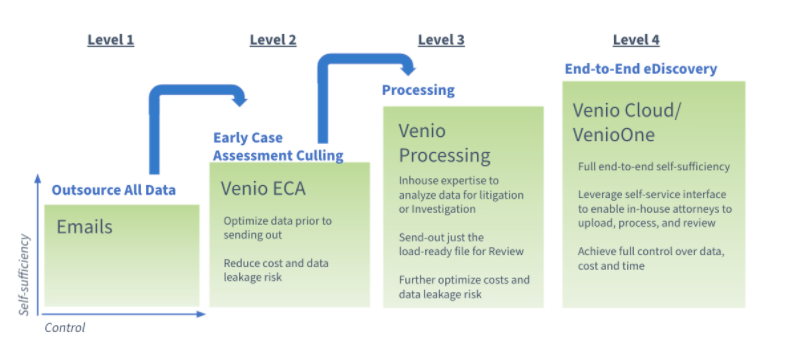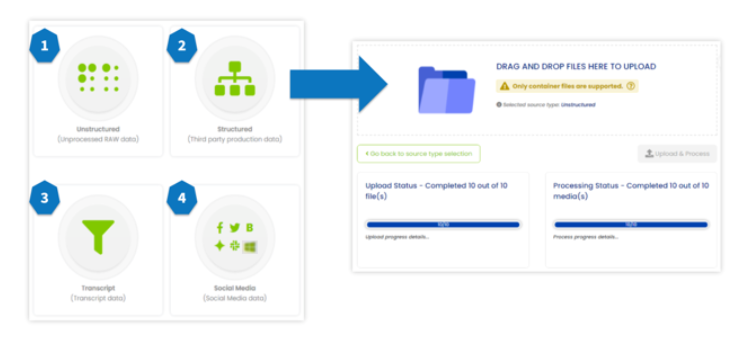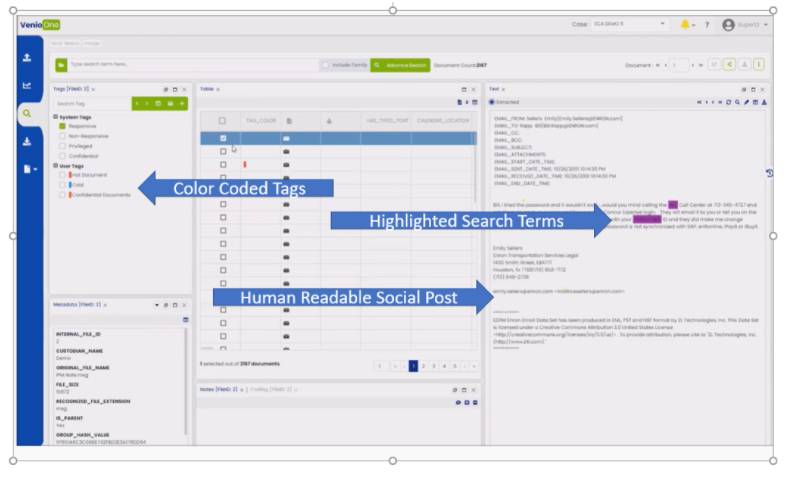Making the transition to a full, end-to-end eDiscovery solution holds many benefits for corporations, law firms, legal service providers and other organizations, but it can be difficult for a variety of reasons. One way to get started is to employ an ECA solution as a first step. In this blog post, we’ll examine how it can be accomplished.
- There are significant challenges involved in going directly into end-to-end eDiscovery.
- Early Case Assessment (ECA) is the ideal foundational step to a full eDiscovery solution.
- Most organizations follow a similar eDiscovery journey.
- The ECA workflow is a major part of this journey and solves many of the challenges.

The Challenges of In-House eDiscovery
Litigation Directors and those in the office of General Counsel are well aware of the challenges associated with launching an in-house eDiscovery solution.
- Knowledge Gap: There’s an uncertainty of not knowing what difficulties lie ahead and the worry that you might choose an eDiscovery vendor who isn’t equipped to meet your specific needs or that an in-house program won’t produce the necessary results or wind up being more expensive than using professional legal services.
- Lack of Resources: Will the move to full, in-house eDiscovery put an undue burden on your company’s time, employees, expertise, and infrastructure?
- Complex Data: These days, companies must contend with hundreds of custodians, petabytes of data, and multiple and varied data sources, including Microsoft Teams, Slack, Zoom — even hand-written notes. One of the main reasons companies are reluctant to take on in-house eDiscovery is that the sheer complexity of data and data sources can be overwhelming.
- Risk Management: All that data must be kept secure, which brings up the difficult task of risk management. Companies must rely on IT and various security programs to maintain and protect that data, particularly when a legal hold is mandated and they have a duty to protect and preserve that data. Ensuring that your intellectual property and your company’s reputation remain protected is a considerable challenge when deciding on what an ideal eDiscovery program would look like.
The Foundational First Step of ECA
The way to meet those challenges is to begin with ECA. ECA is a foundational first step that allows you to get organized and prepared for the transition to full eDiscovery. At this early stage in the process, it’s best to find a system that offers standalone ECA. Going with ECA first will reduce your overall risk and improve your chances for success. What’s more, initiating ECA as a first step will have an immediate positive return on investment (ROI).
With in-place indexing, powerful artificial intelligence with computer learning (CL), and search fundamentals, ECA reduces data to only what is needed for processing. It also keeps the bulk of your data safely protected behind your company firewall.
Going through ECA allows you to fully grasp what a full in-house eDiscovery project will look like. You’ll see and understand how ingestion of data works and see how the AI and search engines work. You’ll work with the user interface, train personnel, and begin to add matters in order to scale your eDiscovery workforce.
Eventually, transitioning to full eDiscovery will allow you to seamlessly pass the data to processing and review. But before that transition takes place, it’s important to note that you can continue to use ECA as a standalone until you are staffed, trained, and understand the capabilities of the full system. You move ahead at your own pace.
The eDiscovery Journey
Many companies in the industry see the eDiscovery journey as a path to both self-sufficiency and control as the dynamics involving volume of data, complexity of data, and connectivity continue to play out. Right now, Venio sees many corporations at Level 1, where their eDiscovery discipline is driven largely through emails, shared drives, and attachments in social media. Venio ECA allows companies at levels 1 or 2 to move to level 3. Some companies have adopted eDiscovery for (semi) ECA and culling-type work, while still relying upon their trusted partners for the majority of their processing and review.
But according to Gartner, Inc., a global research and advisory firm, as many as 70% of enterprises will bring more and more eDiscovery work in-house over the next few years. That means more companies will move to levels 2, 3 or 4. While it looks like we are collectively very far away from Level 4, which means bringing full end-to-end eDiscovery in-house, Venio is already talking to a few organizations that will start testing some variation of that as early as late this year or early next.
That said, Venio also believes the journey will be different for each company. For example, it’s unlikely that most companies will be able to (or frankly even want to) bring the entire eDiscovery process in-house. It’s just not a practical or reasonable goal. In fact, most companies will still work with their LSP partners and outside counsel for critical support. 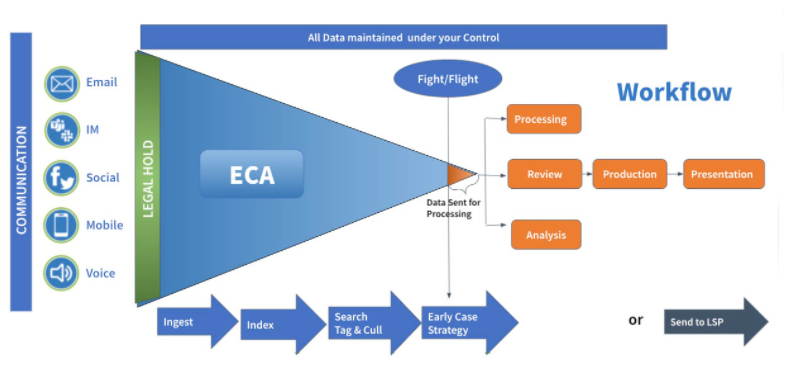
The eDiscovery Workflow
By looking at the full process flow of eDiscovery, it becomes obvious why implementing ECA is a key to success. Ingesting the various data sources is the first step, but an effective ECA program will instantly identify the sources, such as Microsoft Teams, Mobile Cellebrite, Facebook Messenger, emails, MS Office, or hundreds of others.
As part of an automatic process, Venio ECA will in-place index the data for speed, consistency and ease of use. By leaving the data in place as it is indexed, your employees can use powerful AI and Computer Learning to search, tag, and cull the data. Once this primary step is complete, the system creates a small data footprint that will be available to evaluate the data. At this point you’ll have all the key information you need to make strategic early case decisions, meaning you can decide if you want to send the data to your service provider to process, or whether it makes more sense to process, review, and analyze the data internally.
The advantage of this workflow is that you decide which matters you handle yourself and which matters you pass off. You can decide how quickly you’ll move to levels 3 and 4 of eDiscovery based on your specific resources, needs, and knowledge. The transition to full end-to-end eDiscovery will be seamless, and you’ll be able to maintain complete control of your data through the entire process — which can substantially mitigate your risk.
ECA as a Solution to eDiscovery Challenges
Making ECA the first step solves the challenges of taking on full end-to-end eDiscovery by allowing you to get organized making the complete transition. By being organized, you have ample time to train staff and learn the system with a single, easy-to-earn user interface that remains consistent all the way from ingestion to presentation. You’ll be able to scale the effort by evaluating your resources, whether it’s time, employees, or infrastructure in the form of eDiscovery servers and in-place security.
Veno ECA gives you the tools to Investigate your case through the use of powerful AI and computer learning search engines to tag and cull your data, delivering an immediate ROI. You’ll find it easy to manage risk because, thanks to ECA, the files sent to service providers or that are processed internally will only contain relevant matter data. Venio Systems’ ability to identify source data out-of-the box such as Microsoft Teams, Slack, Cellebrite or others, eliminates guesswork with relevant reports and drill-down dashboards simplifying the process and providing early case vision that allow you to make informed strategic decisions earlier in the case. All of these elements lead to a seamless transition to full end-to-end eDiscovery, including legal hold, processing, review, analysis and presentation. And Venio ECA is the foundational first step that makes it all possible.
Step 1: Create the Project
Everything is template based. You can add information with advanced options. This is your data, and these are your custodians. Venio’s system will take care of them. It allows for the incorporation of existing passwords — just drag and drop, and the system will take over from there.
Step 2: Ingest data
There are multiple formats that your data can take: Multiple formats the data can take
Unstructured: Raw data, your company’s hard drives and shared drives
Structured: Data coming from a third party, database data
Transcript Data: From previous cases
Social media: Microsoft Teams, Facebook, Twitter, Bloomberg, Slack, Microsoft Teams, etc. Data ingestion is all drag-and-drop. You don’t have to be an IT expert to use this system. If you can drag and drop, you can load data.
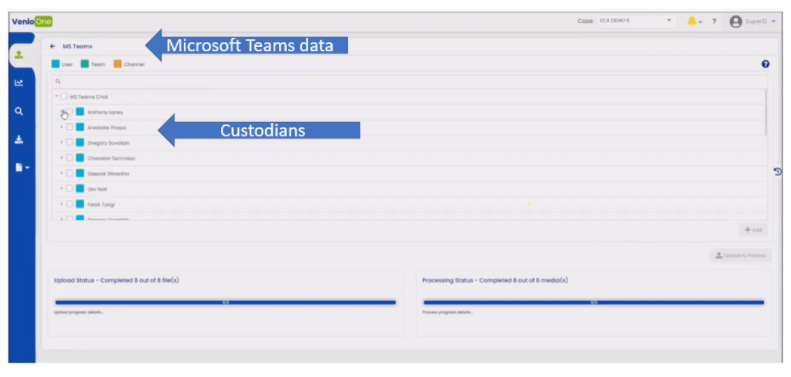
Step 2: Search, Tag and Cull the data
User friendly search criteria allows for tagging and culling of data. Results are in simple to read forms with search criteria highlighted and color coded tags.
Step 5: Export natives
Once a client has data sub-setted out and down to the low-risk, high-quality data that you need for the case, it’s time to get that data out to outside counsel, legal service provider or process in-house. Venio’s system walks clients through the process. They choose what to export based on dynamic folders or tags. The workflow is built on custom export templates, and clients can have as many templates as they want for different scenarios.
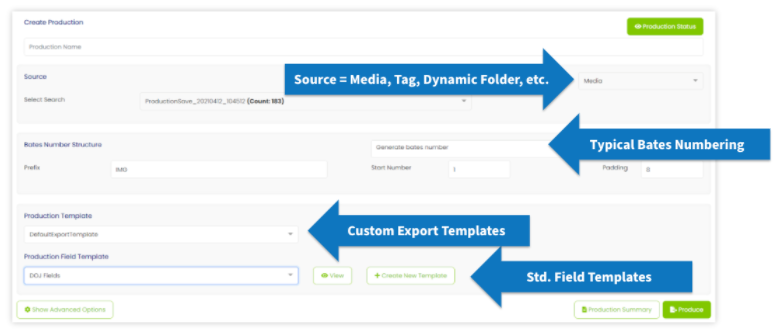
For more information
- To watch a recording of the ECA -First Step in In-House eDiscovery webinar, click here.
- To read the Venio ECA FAQs, click here.
- To download the Venio ECA Product Brief, click here.
- To experience the transformational power of Venio ECA, request a demo today.
